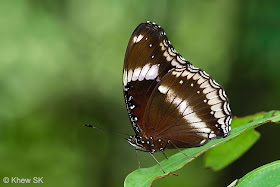The Singapore Rhododendron and Butterflies

Though an under-appreciated plant by horticulturists, the Singapore Rhododendron is a favourite with bird watchers and butterfly enthusiasts. This is because the flowers and fruits are targeted by birds, butterflies and small mammals. In particular, the Scarlet Backed Flowerpecker is a regular visitor to fruiting Melastoma bushes.

The Singapore Rhododendron usually grows as a "weed" in untended areas, normally up to a metre high, and if left to grow, can reach heights of up to 3 metres. It is a small shrub, that has tiny scales on its branches and petioles. The leaves are narrow and lanceolate, about 5-10 cm long, usually with 3 prominent veins running from the base.

The flowers are light pink-purple, with elbowed anthers surrounding the style, and are borne in clustered inflorescences. The fruit is interesting, a sort of pod, usually about 1.5 cm long, which is covered in small bumps and topped with a persistent calyx.

The greenish pod splits open halfway and flips over to reveal a fleshy deep purple structure studded with numerous (about a thousand) tiny seeds, and is usually 5-sectioned. The fruits are berry-like and break open irregularly. The seeds stain the mouth when eaten, and is sweet and slightly astringent.

A Purple Duke extends its proboscis deep into the fruit of the Singapore Rhododendron. Note the white seeds covering the fruit
The Singapore Rhododendron and Butterflies



Whilst butterflies are occasionally observed to feed on the nectar of the purple-pink flowers, the primary pollinators appear to be bees and wasps.

It is the ripening fruits that are irrestible to butterflies, and when a bush has many such ripened fruits, there will often be swarming with butterflies of the Nymphalidae and Lycaenidae families.

From many such encounters, ButterflyCircle members have observed that many butterflies that feed on the sweet ripened fruits can sometimes be so intoxicated as to be able to be picked off the fruits with our fingers! They can stay still and continue feeding for long periods of time, allowing the photographer to shoot many shots of a species that is usually skittish and difficult to approach.



A Commander (Moduza procris milonia), a Common Palmfly (Elymnias hypermnestra agina) and a Grey Sailor (Neptis leucoporos cresina) feeding on the fruits of the Singapore Rhododendron
Interestingly, butterflies of the Papilionidae, Pieridae, Riodinidae and Hesperiidae families seem to have less preference for the fruits of the Singapore Rhododendron.

For the butterflies that feed on the ripened fruits, they often have to share the sweet bounty with ants, bees and wasps. The latter two feeders tend to also scare the butterflies away as they barge in onto the fruits.

After having their fill of the fruit juices, many of the Nymphalidae, particularly from the genera Tanaecia and Euthalia, will rest in nearby shady spots or sunbathe with their wings opened on sunlit leaves. This gives further opportunities to observe and photograph the butterflies when they are slightly more lethargic than usual.

An Acacia Blue (Surendra vivarna amisena) feeds on the ripened fruit of the Singapore Rhododendron

A female Purple Duke (Eulaceura osteria kumana) feeds on the ripened fruit of the Singapore Rhododendron next to a goblet-shaped fruit that has yet to ripen
Besides providing a food source for the adult butterflies, the Singapore Rhododendron is also the known host plant to the Horsfield's Baron (Tanaecia iapis puseda) and two Lycaenids - the Long Banded Silverline (Spindasis lohita senama) and Semanga superba deliciosa. The caterpillars of all three species feed on the leaves and shoots of the plant.


A female Horsfield's Baron (Tanaecia iapis puseda) oviposits on the leaf tip of the Singapore Rhododendron, and the 5th instar caterpillar of the Horsfield's Baron


Two pretty Lycaenids - The Long Banded Silverline (Spindasis lohita senama) and Semanga superba deliciosa whose caterpillars depend on the Singapore Rhododendron as one of their caterpillar host plants




































